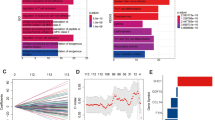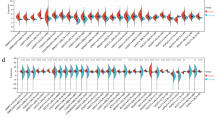Abstract
Background
Signal transducer and activator of transcription (STAT) 3 plays a vital role in carcinogenesis and drug response. Platinum-based chemotherapy is the first-line treatment for lung cancer patients, especially those in advanced stages. In the present study, we investigated the association of STAT3 polymorphism rs4796793 with lung cancer susceptibility, platinum-based chemotherapy response, and toxicity.
Methods
A total of 498 lung cancer patients and 213 healthy controls were enrolled in the study. 467 of them received at least 2-cycle platinum-based chemotherapy. Unconditional logistical regression analysis was used to assess the associations.
Results
STAT3 rs4769793 G allele carriers had an increased susceptibility of lung cancer [additive model: adjusted OR (95% CI) 1.376 (1.058–1.789), P = 0.017; recessive model: adjusted OR (95% CI) 1.734 (1.007–2.985), P = 0.047]. Rs4769793 was not significantly associated with platinum-based chemotherapy response in lung cancer patients. STAT3 rs4796793 was associated with an increased risk of severe overall toxicity [additive model: adjusted OR (95% CI) 1.410 (1.076–1.850), P = 0.013; dominant model: adjusted OR (95% CI) 1.638 (1.091–2.459), P = 0.017], especially hematological toxicity [additive model: adjusted OR (95% CI) 1.352 (1.001–1.826), P = 0.049].
Conclusions
STAT3 rs4796793 may be considered as a potential candidate biomarker for the prediction of susceptibility and prognosis in Chinese lung cancer patients. However, well-designed studies with larger sample sizes are required to verify the results.






Similar content being viewed by others
References
Chen W, Zheng R, Baade PD et al. (2016) Cancer statistics in China, 2015. CA Cancer J Clin 66(2):115–132. https://doi.org/10.3322/caac.21338
Gong WJ, Yin JY, Li XP et al. (2016) Association of well-characterized lung cancer lncRNA polymorphisms with lung cancer susceptibility and platinum-based chemotherapy response. Tumour Biol 37(6):8349–8358. https://doi.org/10.1007/s13277-015-4497-5
Yu H, Pardoll D, Jove R (2009) STATs in cancer inflammation and immunity: a leading role for STAT3. Nat Rev Cancer 9(11):798–809. https://doi.org/10.1038/nrc2734
Chai EZ, Shanmugam MK, Arfuso F et al. (2016) Targeting transcription factor STAT3 for cancer prevention and therapy. Pharmacol Ther 162:86–97. https://doi.org/10.1016/j.pharmthera.2015.10.004
Yu H, Lee H, Herrmann A et al. (2014) Revisiting STAT3 signalling in cancer: new and unexpected biological functions. Nat Rev Cancer 14(11):736–746. https://doi.org/10.1038/nrc3818
Lee HJ, Zhuang G, Cao Y et al. (2014) Drug resistance via feedback activation of Stat3 in oncogene-addicted cancer cells. Cancer Cell 26(2):207–221. https://doi.org/10.1016/j.ccr.2014.05.019
Barre B, Vigneron A, Perkins N et al. (2007) The STAT3 oncogene as a predictive marker of drug resistance. Trends Mol Med 13(1):4–11. https://doi.org/10.1016/j.molmed.2006.11.001
Huang S, Chen M, Shen Y et al. (2012) Inhibition of activated Stat3 reverses drug resistance to chemotherapeutic agents in gastric cancer cells. Cancer Lett 315(2):198–205. https://doi.org/10.1016/j.canlet.2011.10.011
Zhao L, Zhang Q, Luan X et al. (2015) STAT3 and STAT5b polymorphism contributes to breast cancer risk and clinical outcomes. Int J Clin Exp Pathol 8(2):2033–2038
Sonnenblick A, Uziely B, Nechushtan H et al. (2013) Tumor STAT3 tyrosine phosphorylation status, as a predictor of benefit from adjuvant chemotherapy for breast cancer. Breast Cancer Res Treat 138(2):407–413. https://doi.org/10.1007/s10549-013-2453-x
Gong W, Xiao D, Ming G et al. (2014) Type 2 diabetes mellitus-related genetic polymorphisms in microRNAs and microRNA target sites. J Diabetes 6(4):279–289. https://doi.org/10.1111/1753-0407.12143
Ito N, Eto M, Nakamura E et al. (2007) STAT3 polymorphism predicts interferon-alfa response in patients with metastatic renal cell carcinoma. J Clin Oncol 25(19):2785–2791. https://doi.org/10.1200/jco.2006.09.8897
Gong WJ, Peng JB, Yin JY et al. (2017) Association between well-characterized lung cancer lncRNA polymorphisms and platinum-based chemotherapy toxicity in Chinese patients with lung cancer. Acta Pharmacol Sin 38(4):581–590. https://doi.org/10.1038/aps.2016.164
Duffaud F, Therasse P (2000) New guidelines to evaluate the response to treatment in solid tumors. Bull Cancer 87(12):881–886
Trotti A, Colevas AD, Setser A et al. (2003) CTCAE v3.0: development of a comprehensive grading system for the adverse effects of cancer treatment. Semin Radiat Oncol 13(3):176–181. https://doi.org/10.1016/s1053-4296(03)00031-6
Jiang B, Zhu ZZ, Liu F et al. (2011) STAT3 gene polymorphisms and susceptibility to non-small cell lung cancer. Genet Mol Res 10(3):1856–1865. https://doi.org/10.4238/vol10-3gmr1071
Wang KN, Zhou B, Zhang J et al. (2011) Association of signal transducer and activator of transcription 3 gene polymorphisms with cervical cancer in chinese women. DNA Cell Biol 30(11):931–936. https://doi.org/10.1089/dna.2010.1179
Xie J, Zhang Y, Zhang Q et al. (2013) Interaction of signal transducer and activator of transcription 3 polymorphisms with hepatitis B virus mutations in hepatocellular carcinoma. Hepatology 57(6):2369–2377. https://doi.org/10.1002/hep.26303
Zhao H, Wang Z, Wu H et al. (2015) STAT3 genetic variant, alone and in combination with STAT5b polymorphism, contributes to breast cancer risk and clinical outcomes. Med Oncol 32 (1). https://doi.org/10.1007/s12032-014-0375-z
Zhou F, Cheng L, Qiu LX et al. (2016) Associations of potentially functional variants in IL-6, JAKs and STAT3 with gastric cancer risk in an eastern Chinese population. Oncotarget 7(19):28112–28123. https://doi.org/10.18632/oncotarget.8492
Sellier H, Rebillard A, Guette C et al. (2013) How should we define STAT3 as an oncogene and as a potential target for therapy?. JAKSTAT 2 (3):e24716. https://doi.org/10.4161/jkst.24716
Walch-Ruckheim B, Pahne-Zeppenfeld J et al. (2016) STAT3/IRF1 pathway activation sensitizes cervical cancer cells to chemotherapeutic drugs. Cancer Res 76(13):3872–3883. https://doi.org/10.1158/0008-5472.can-14-1306
Yamamoto K, Ioroi T, Kanaya K et al. (2016) STAT3 polymorphism rs4796793 may be a predictive factor of tumor response to multiple tyrosine kinase inhibitors in metastatic renal cell carcinoma in Japanese population. Med Oncol 33 (3):24. https://doi.org/10.1007/s12032-016-0733-0. (Northwood, London, England)
Jenkins BJ, Roberts AW, Greenhill CJ et al. (2007) Pathologic consequences of STAT3 hyperactivation by IL-6 and IL-11 during hematopoiesis and lymphopoiesis. Blood 109(6):2380–2388. https://doi.org/10.1182/blood-2006-08-040352
Kirito K, Osawa M, Morita H et al. (2002) A functional role of Stat3 in in vivo megakaryopoiesis. Blood 99(9):3220–3227
Acknowledgements
The authors thank all the subjects who volunteered to take part in the study.
Funding
The work was supported by the National Key R&D Program of China (No. 2017YFC0909900) and Hubei Province health and family planning scientific research project (WJ2017M118).
Author information
Authors and Affiliations
Corresponding author
Ethics declarations
Conflict of interest
All authors have no conflict of interest to disclose.
Ethical approval
All procedures performed in studies involving human participants were in accordance with the ethical standards of the institutional and/or national research committee, and with the 1964 Helsinki declaration and its later amendments or comparable ethical standards.
Informed consent
Informed consent was obtained from all individual participants included in the study.
Additional information
Publisher’s Note
Springer Nature remains neutral with regard to jurisdictional claims in published maps and institutional affiliations.
Electronic supplementary material
Below is the link to the electronic supplementary material.


About this article
Cite this article
Gong, WJ., Ma, LY., Hu, L. et al. STAT3 rs4796793 contributes to lung cancer risk and clinical outcomes of platinum-based chemotherapy. Int J Clin Oncol 24, 476–484 (2019). https://doi.org/10.1007/s10147-018-01386-7
Received:
Accepted:
Published:
Issue Date:
DOI: https://doi.org/10.1007/s10147-018-01386-7




